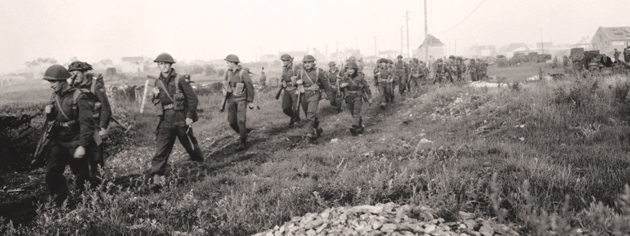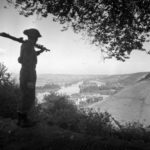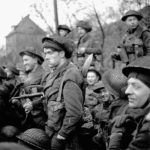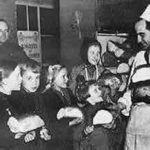In August 1944, Henri found himself overseas, and joining the allied effort just after D-Day. By this time Henri had been in the army for over 18 months, of which he had prepared for and participated in an amphibious landing and spent many more months training back in Canada. The story is that he was “ready to go”.
Private Henri Richard joined the “Queen’s Own Cameron Highlanders of Canada”, which was part of the 2nd Canadian Infantry Division – 6th Infantry Brigade, on 8 Aug 44. At this time the regiment had just completed the battle at Caen and had just started the first drive towards Falaise. The Camerons were situated very near Bretteville-Sur-Laize in the Laize River Valley.
Back home in St. Genevieve, Manitoba, Henri’s parents were worried about their oldest son, but proud enough to put up a map of France on the wall. Every day from the newspaper and radio news Henri’s parents would track the allies progress on the map.
The present attack on Falaise stalled short of the objective on 9-10 Aug 44. The Cameron’s were situated on the right flank of the drive still in the Laize River valley.
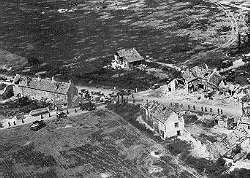
the road from Caen to Falaise.
The second drive towards Falaise began on 14 Aug 44. This was called OPERATION TRACTABLE. The main thrust of the drive came from armoured regiments moving southeast across the axis of the Caen-Falaise Road and the Laison River valley. The densely packed columns of armoured vehicles created clouds of dust which added to an extensive smoke screen. The Laison River Valley was quickly filled with a dense blanket of dust and smoke which blotted out the sun.
The forces of the 2nd Division (Camerons) were assigned to move directly towards the town of Falaise. 6 Brigade (Camerons) fought their way towards La Cressoniere and La Chesnaie. Forward elements advanced so quickly that friendly bombers dropped bombs on them by mistake.
One aspect of the battle was that on the night of the 13th a scout car from the 8th Recce Regiment (14th Canadian Hussars) lost direction and drove into enemy lines. The Germans captured documents containing the next day’s operations. This caused more difficulty in the taking of Falaise.
While the fighting for Falaise was occurring the remainder of the Allied forces were in the process of trapping several German units in a pocket to the southwest. To help close the gap, Canadian Armoured Regiments were ordered further south and east. This left the Canadian 2nd Division to take Falaise.
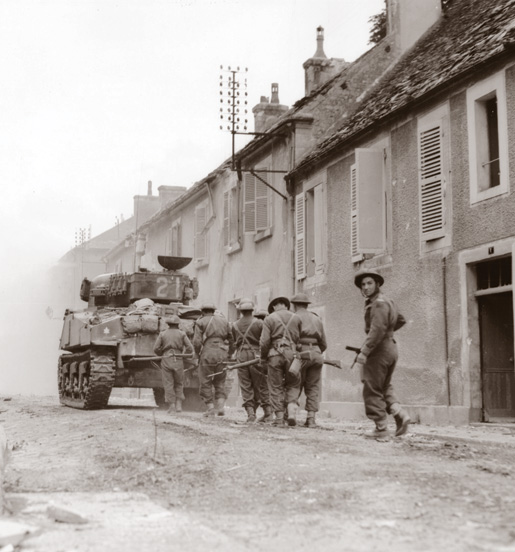
6 Brigade entered Falaise at 1500 hours on the 16th of August. The roads were virtually impassable due to bomb craters. A small group of the German 12 SS were holding positions in the town and were prepared, and ordered to, to fight to their death.
Over the night of the 16th the Camerons and the South Saskatchewan Regiment held a small part of Falaise. They were joined on the morning of the 17th by the Fusiliers Mont-Royal Regiment. By 0200 hours on the 18th they had finally dislodged the final German resistance in the town of Falaise.
Meanwhile other Canadian elements were sweeping towards the town of Trun in an attempt to cut off the Germans. Major elements of the German army were cut off as they tried to escape through the “Falaise Gap”. This resulted in a major victory for the allies. All remaining elements of the German Army then fell back in a defensive position just west of the Seine River.
The 2nd Division handed over it’s occupation of Falaise to the British on the 20th and joined in the pursuit of the retreating Germans on the 21st. By the 22nd elements of 2 Division had established a crossing of the River Toques. The Camerons crossed the river on trucks of the Royal Canadian Army Service Corp and encountered no resistance before reaching Orbec. The 14th Canadian Hussars (the recce regiment) had luckily crossed the river to the west and circled back to enclose Orbec from the North. Orbec was then cleared in a joint attack which involved the Camerons.
